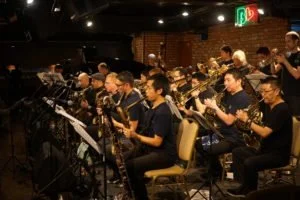TOKYO BIG BAND
October 25, 2019 at B Flat, Akasaka
Tokyo Big Band
(東京ビッグバンド)
Jonathan Katz ジョナサン・カッツ– piano, conductor
Steve Sacks スティーブ・サックス—saxophone
Gustavo Anacleto グスターヴォ・アナクレート—saxophone
Masanori Okazaki 岡崎正典—saxophone
Shunosuke Ishikawa 石川周之介—saxophone
Kensuke Miyaki 宮木謙介—saxophone
Isao Sakuma 佐久間勲—trumpet
Takahiro Mikami 三上貴大—trumpet
Ryuichi Takase 高瀬龍一—trumpet
Mike Zachernuk マイク・ザッチャーナック—trumpet
Tomoki Mitsuka 三塚知貴—trombone
Yuu Uesugi 上杉優—trombone
Masahito Kawahara 川原聖仁—trombone
Masaki Domoto 堂本雅樹—trombone
Yukihiro Nakazawa 中澤幸宏—french horns
Daisuke Kikuchi 菊地大輔—french horns
Daiki Yasukagawa 安ヵ川大樹—bass
Ryo Shibata 柴田亮—drums
Christopher Hardy クリストファー・ハーディ—percussion
Guest:
Toshiro Nakanishi 中西俊博—violin
One of the ironies of the big band scene in Japan is that one of the most exquisitely Japanese big bands is led by a foreigner, Jonathan Katz. Of course, that’s not a real irony, as Katz has been living in Japan and writing music from a wide range of traditions. What makes this big band special is not just the stellar musicianship and intriguing arrangements, but the original approach to tunes based on, adapted from and influenced by Japanese music. That multi-cultural approach to creating music is, after all, at the heart of jazz.
Especially nice are how an arrangement of “Aka Tanbo” works so well with Katz’s arranging and leadership. The musicians’ sensitivity to how big band form and traditional Japanese music go together so perfectly is a shared sensibility that pushes the musicians into playing with attention, energy and grace. The band works with harmonies and a soft palette for most works, such as on the tribute to the victims of 9/11, but they can also rave up on songs like “Green Sauce” and “Bodegalicious,” the latter two originals bringing in Latin rhythms that add yet another cultural layer to the music. Listeners are meditating on the subtle beauty one minute, and ready to get up and mambo the next. The variety of textures is another element the big band takes from the heart of jazz.
Those varieties and layers are what keep some of the top musicians in Tokyo coming back to play with the Tokyo Big Band so consistently. With such musicians, the band’s solos are consistently powerful and innovative, drawing on and shaping the tunes. Solos are not belted out, but deeply felt. The musicians move from slow, retro moments to fresh, vibrant melodizing. The choice of soloist on every number was clearly made with care, with the tone, feel and individuality of the soloist fitting the songs perfectly.
Standouts are hard to select, but “Umi” was startling poignant, as was “Oborozuki Meditation,” with its cool bass line and the slow soft, French horn. And how many bands dare to include French horn? Katz’s does! It’s another instrument he’s mastered, and almost always included in his charts. “Rain Dance” and “Like the Wind” were complex and intense, with the sections of the big band playing off each other with symphonic sophistication.
Though Katz included a few standards, “You and the Night and Music” was especially well done, it’s the originals that really grab you. Part of their beauty comes from the ‘extras,’ like the intros and endings of the tunes, which are never throwaways, or even throw-downs, but rather offer another insight into the nature of the composition and the way the musicians play it so naturally.
This group has developed over the years into a must-see big band, among the numerous great big bands in Japan. Whatever style jazz one likes, this band will be an engaging delight.





